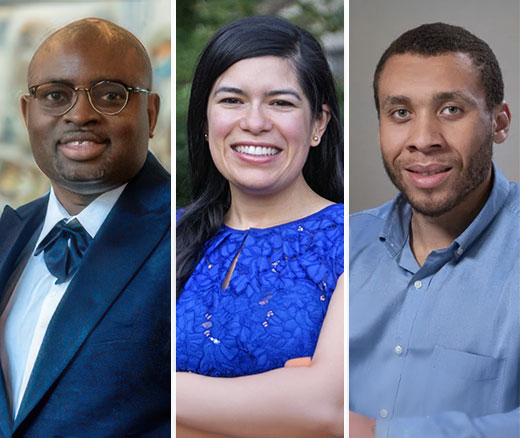
Safeguarding Nursing Science Amid Political Retrenchment
Experts Say Nursing Ethics Can Help Researchers Confront Federal Disinvestment, Defend Science, and Advance Health Equity
Blog Post

The presence of marginalized communities in pediatric clinical trials is concerningly low, especially for Black and Indigenous people. A history of medical exploitation and systemic exclusion has contributed to widespread mistrust that deters participation. Other barriers persist as well. As a result, data continues to underrepresent these communities, threatening the validity of medical findings and perpetuating disparities in outcomes. Because trials must ensure that new care is safe and effective for all, addressing this gap is both a scientific necessity and a matter of equity.
To cultivate diversity in trials, Senior Fellows Kevin Johnson and Andy Tan, along with colleagues, explored several solutions, and one of them worked: $25 gift cards. The main intervention—culturally relatable video messages—did not help alone.
The study was unusual in that no one had studied whether this tailored approach works in getting parents to enroll their children in trials, the researchers said, noting that more work is needed to confirm their results.
“This work introduces a new way for us to think about achieving research enrollment with historically marginalized groups,” said Johnson. “It paves the way for a larger study teasing apart the relative contributions of tailoring and monetary incentives in improving study recruitment.”
Read below our Q&A with the study’s first and last authors, Kevin Johnson and Andy Tan.
Johnson: I arrived at the University of Pennsylvania interested in understanding how to effectively deliver health communication and other messages to parents of children with chronic illnesses, hoping to improve their enrollment in clinical research. One approach in the literature was tailoring to personalize messages to specific audiences. Tailoring is a time-consuming strategy, and the literature was mixed about its impact. After discussing this with Dr. Tan, we decided to investigate the effect of tailoring, using specific appeals designed to frame clinical research as important.
As a pediatrician, I was particularly interested in how messaging to parents about trials for children affected enrollment. We couldn’t find research on that. Therefore, we constructed a study comparing tailored “inclusion appeals” to untailored video messages, hypothesizing that tailoring would improve parent’s willingness to enroll their children.
Johnson: This project, though on a small sample of parents from one academic site, did not show any difference in parents’ willingness to enroll children when a tailored message was used compared with an untailored video or a control group of participants who read the first page of a clinical trials registry website. However, one curious finding is that we performed a post hoc study, giving a fourth group a much lower incentive for participating. The randomized trial group received a monetary incentive, while the post-hoc study group received a nice ink pen. That group had an enrollment rate much lower than those who received a monetary incentive. This suggests that combining messaging with a monetary incentive may be the best way to improve enrollment in clinical trials.
Again, tailoring is onerous—although in the world of generative AI, the cost of creating a video from a text description is dropping. Monetary incentives were often considered tantamount to coercion if they were too excessive, which would be unethical if abused by researchers.
Johnson: It is widely accepted in experimental study design that economic incentives reimburse for time and expenses associated with participation. It also may provide a measure of the study’s risk and the value of the results to society. What’s also clear is that trust and altruism are needed for populations to engage in the experimental or research process. We’ve all heard about the challenges of some groups who were put into experiments without their knowledge historically. While these groups may deem academic organizations untrustworthy, research has shown that there may be a willingness to participate in research when there is a direct benefit, such as economic incentives, that circumvents mistrust.
Tan: We tested culturally tailored messages because we knew from previous research with adults that adapting health messaging to speak to a community’s experiences, values, and history—not just putting diverse faces in a video—can help break down barriers to participating in clinical trials. Surprisingly, no one has studied whether this approach works for getting parents to enroll their children in trials. We saw this as a chance to address trust issues using this approach. That’s why we partnered with our Research Advisory Group to create messages that directly acknowledged historical concerns and that utilized information arising from parents in the community. We wanted to go deeper than just changing what people saw on the surface.
Johnson: It is a single-site study using an indirect measure of clinical trial enrollment (enrolling in a research registry). It would benefit from a clinical trial with a specific incentive/no-incentive group to validate our findings. Importantly, we focused on African American patients, where other historically marginalized groups would also need to be studied. The paper goes into more detail about other limitations.
Tan: Trust in medical research, which is deeply rooted in historical experiences, particularly for marginalized communities, may also be a limitation because it impacts people’s decisions to participate. Trust operates at multiple levels—trust in the health care system broadly, trust in research institutions specifically, and trust in individual researchers and clinicians for a particular study. Our pilot revealed something interesting about these dynamics: while building trust through culturally tailored communication is important, sometimes providing tangible benefits might be a more direct way to bridge trust gaps. This challenges traditional approaches to addressing medical mistrust in research recruitment.
Johnson: The number one recommendation is to address barriers preventing the use of economics and communication science to improve clinical trial enrollment and to work with local and national policy organizations to remove barriers. Studies of payment for research in the U.S. by Grady and colleagues show significant variation in the payment amount. Could this be standardized? Should we recognize that unique groups might require tailoring the incentive package to address their needs? In the world of generative AI, we need to understand if AI-generated study materials (which will support much more robust tailoring) are allowed and, if allowed, are tolerated by potential participants. The body of research in this space would support further initiatives around improving participant recruitment in clinical trials.
Tan: These null findings haven’t discouraged us—they’ve opened up some fascinating new questions about how to best promote diverse participation in clinical research.
First, we need to conduct a larger trial that tests explicitly different combinations of messaging and forms of incentives across multiple historically marginalized populations—not just African American families.
Second, we should examine actual clinical trial enrollment rather than just registry enrollment since that’s the ultimate goal.
Finally, we’re interested in exploring whether there’s an optimal balance between incentive levels and messaging approaches. For instance, could smaller incentives be equally effective when paired with culturally tailored and community-informed messaging? Dr. Johnson raised the emergence of AI-generated content as opening new possibilities for creating personalized messages at scale. However, we must carefully assess how different communities would trust and respond to AI-generated materials.
The study, “Culturally Tailored Messages and Trial Registry Enrollment: A Randomized Clinical Trial,” was published on November 12, 2024, in JAMA Network Open. Authors include Kevin B. Johnson, Stacy L. Iannone, Susan L. Furth, Lynne Taylor, and Andy S. L. Tan.


Experts Say Nursing Ethics Can Help Researchers Confront Federal Disinvestment, Defend Science, and Advance Health Equity

Study Finds Major Gaps in Cardiac Care Behind Bars

Eighth Year of Program That Recruits, Mentors and Develops Junior Faculty for Health Services Research

Chart of the Day: National Study Shows White Patients More Likely Than Black Patients to Get CT and/or Ultrasounds for Abdominal Pain in the Emergency Department

LDI Fellows Uncover Six Key Barriers and Solutions to Achieving Better Hospital Care

The Prison System Often Fails to Meet Even Basic Standards for Pre- and Post-Operative Health, Experts Say